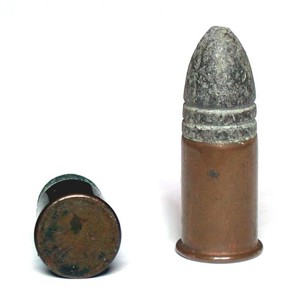Centerfire vs Rimfire
Are these brand names or categories? What’s the difference?

A rimfire cartridge. The primer is located in the “ridge” at the bottom of the casing. The firing pin strikes the edge of the casing, on the backside of this ridge.
(Credit: Wikimedia Commons)
These two terms are categories of ammunition, not brand names. Any cartridge is either centerfire or rimfire, not both.
The name refers to where in the casing the primer is located. Primer is what ignites after being hit by the firing pin. It, in turn, ignites the gunpowder, that creates the explosion that propels the bullet forward.
With rimfire, the primer is located in a ring around the rim of the casing. The firing pin doesn’t hit the middle of the casing – it actually impacts around the edge. With centerfire, the primer is located in the center of the casing, and the firing pin hits right in the middle.
(I couldn’t find a resource that explainex exactly why rimfire has primer around the rim, but here’s my guess: the firing pin hits the rim and rapidly compresses or squeezes the primer in this confined space. This generates heat, which ignites it.)
You can tell the two types apart, as the centerfire cartridge has a “disc” in the middle, often a different color or shade, while the rimfire cartridge is flat and featureless.
Centerfire cartridges can be reloaded and reused, while rimfire is single-use only. The main advantage of rimfire is that they are much cheaper to manufacture, since they have no separate parts and require no assembly.
In general, centerfire is more modern. Rimfire is limited to smaller ammunition (it’s very common in .22 caliber rifles).
Why I Looked It Up
I read a Wikipedia article about the murder of Ken KcElroy:
While sitting in his truck, McElroy was shot at several times but hit only twice – once by a centerfire rifle and once by a .22 rimfire rifle.